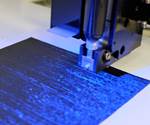Graphene-enhanced prepreg launched for lightning strike protection
Haydale's range of graphene-enhanced prepreg materials utilize functionalized nanomaterials to improve the electrical conductivity in aerospace applications.

Source | Haydale
Haydale (Ammanford, U.K.) has launched a range of graphene-enhanced prepreg material for lightning strike protection, utilizing functionalized nanomaterials to improve the electrical conductivity. The material can be used for structural components or for enclosures for electronic avionics systems.
According to Haydale, the material also has potential applications for unmanned aerial vehicles (UAV), commercial aviation or space applications, or offshore wind turbine blades.
The material has been developed in collaboration with Airbus UK (Bristol), BAE Systems (Farnborough, U.K.), GE Aviation (Evendale, Ohio, U.S.) and Element Materials Technology Warwick Ltd. (Warwick, U.K.), within the U.K.’s National Aerospace Technology Programme (NATEP)-supported GraCELs 2[1] project, where the first iterations of materials were developed and subjected to lighting strike tests. The consortium is now looking to manufacture a demonstrator component using the developed materials to establish composite manufacturing protocols for commercial purposes.
An electrically conductive masterbatch is also commercially available, and the Haydale team has been working with customers to test the capability achieving significant results over existing materials.
Related Content
-
DLR completes MFFD upper shell skin layup
Eight-meter-long CFRTP fuselage skin was achieved via laser-heated in-situ consolidation, with stringers, frames and cleats to be welded.
-
Understanding vacuum bagging layers in production, repair
Recognizing the functions of each layer in a vacuum bag schedule can help users discover what vacuum bag schedules work best for their application.
-
TCR Composites introduces TR1116 snap-cure epoxy prepreg resin system
Designed for press-cure applications, the resin system is highlighted for its snap-cure capability and tailored properties.

.jpg;width=70;height=70;mode=crop)














